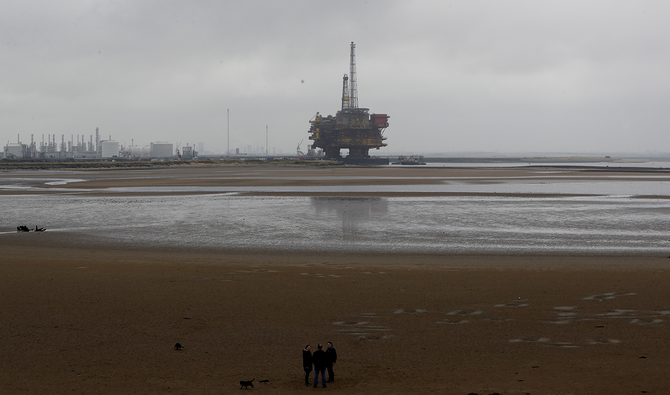
- ARAB NEWS
- 23 Apr 2024

Last week was challenging for oil markets and things took a turn for the worse over the weekend.
The number of coronavirus disease (COVID-19) cases spiraled out of control in the US surpassing the 9 million mark. In Europe, governments saw no alternative than to reimpose restrictions and lockdowns to varying degrees.
British Prime Minister Boris Johnson announced on Saturday that from Nov. 5 to Dec. 2 restaurants, bars, pubs, and all nonessential retail would be closed again. The government also banned all travel, except for business-critical trips, and decreed that social interactions would have to be reduced to an absolute minimum.
The UK government has predicted that the cost to the economy could be as high as £20 billion ($25.83 billion), which is why Chancellor of the Exchequer Rishi Sunak extended the furlough scheme for another month.
Such drastic measures have an impact on oil demand. Some oil traders think that the collective attempts at curbing the virus could take as many as 3 million barrels per day (bpd) out of the market.
The recent resurgence of the virus has definitely had a big impact on oil prices which reached their lowest levels in five months. The commodity lost around 10 percent last week and its decline continued into Monday. Mid-morning central European time (CET), Brent reached $37.30 per barrel and West Texas Intermediate (WTI) $35.01 per barrel now trading in the mid-$30s, compared to a trading range of around $40 only a week earlier.
As though a declining demand was not bad enough, Libya returned to the markets with a vengeance. In August, Libyan production was around 80,000 bpd, because Libyan National Army leader Khalifa Haftar blocked oil installations, which are under the control of the Libyan National Oil Co. and with it the UN-recognized government of Prime Minister Fayez Al-Sarraj.
The breakthrough in the latest cease-fire talks in Geneva resulted in Haftar allowing the oil to flow again. Production neared the 600,000-bpd mark and by the end of the year will grow to 1 million bpd (Libya produced 1.2 million bpd at the beginning of the year). Libya and Iran are exempt from the production cuts of OPEC+, an alliance between the OPEC nations and their 10 allies led by Russia.
Still life is tough in the oil patch, not just for upstream companies, but also for refiners who saw their margins decimated. Shell will reduce its refineries to six over the coming years and other majors are also reviewing their refining portfolio.
It is not all doom and gloom though. China is recovering nicely from the economic downturn, posting manufacturing purchase managers’ index (PMI) numbers indicating that its economy is picking up nicely. China’s manufacturing PMI stood at 51.4. South Korea and Taiwan boasted manufacturing PMIs of 51.2 and 55.1, respectively (a PMI above 50 indicates that the sector is growing and below 50 that it is contracting).
Global crude inventories declined by 2 million bpd in September and October. Whether this will continue on that trajectory depends on the global demand and supply balance going forward.
This poses a dilemma for OPEC+ which is scheduled to reduce its 7.7 million bpd of cuts to 5.8 million bpd from January through April. The alliance will have to weigh up whether that is feasible when ministers meet on Nov. 30/Dec. 1. It all will depend on how much the various lockdowns have impacted on demand as well as taking into consideration the impact of growing economies in East Asia.
Supply is the other issue. OPEC+ will have to decide whether to impose production limitations on Libya, which has so far been exempt from the cuts.
In this context it was interesting to hear Russian President Vladimir Putin state that he was not entirely opposed to extending the alliance’s current production cuts through April 2021. It has traditionally not been easy for OPEC and its kingpin Saudi Arabia, to convince Russia of cuts, because the oil industry in Siberia and elsewhere in the country has always been eager to resume production and lobbied hard for it. Expect the telephone diplomacy between Moscow, Riyadh, and other assorted capitals to gather pace ahead of the OPEC+ ministerial meeting.
This leaves us with the impact of the US presidential election on the oil markets.
It is certain that Democrat Joe Biden will impose stronger environmental conditions on the industry if he wins the election. He would also take the US back into the Paris Agreement on climate change.
It may sound counterintuitive, but in the short run a potential President Biden could have a positive impact on North American oil consumption, because he is expected to come up with stronger stimulus packages than the Republicans would. This will especially hold true if he embarks on (former US President Franklin D.) Roosevelt-style infrastructure spending, which could raise oil demand substantially.
A return of the US to the Joint Comprehensive Plan of Action (JCPOA) and the lifting of sanctions for Iranian oil exports under a Biden presidency may not be straightforward and would take time. The results would be felt on the oil markets by mid-2021 at the very earliest.
All in all, oil markets are not in a good place as they are again faced by the twin shocks of lower demand and higher supplies. To get a clearer picture, one has to wait to see whether lockdowns can contain the virus, if Asia continues to grow, and what the outcome of the US election will be. In the meantime: Fasten your seatbelts.
• Cornelia Meyer is a Ph.D.-level economist with 30 years of experience in investment banking and industry. She is chairperson and CEO of business consultancy Meyer Resources. Twitter: @MeyerResources